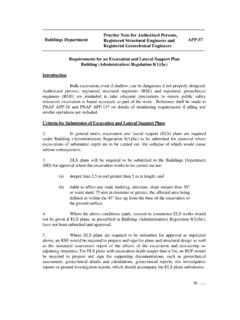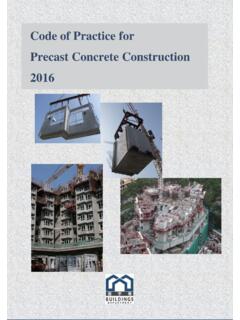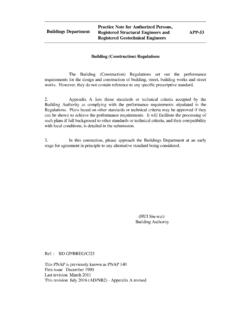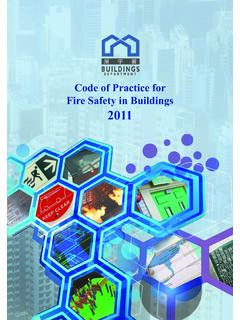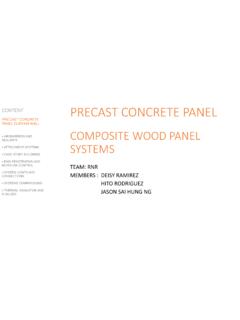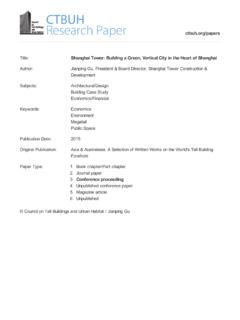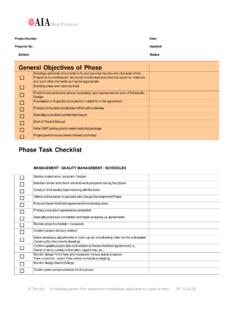Transcription of Code of Practice - Buildings Department
1 Code of Practice for Structural Use of Glass 2018. FOREWORD. This Code of Practice for the Structural Use of Glass (the Code) provides guidelines on the design , construction, testing and quality assurance of structural glass in Buildings . Although the Code is not a statutory document, compliance with the requirements of the Code is deemed to satisfy the relevant provisions of the Buildings Ordinance and related regulations. The Code was prepared by the Buildings Department on the basis of a consultancy study on the structural use of glass commissioned by the Buildings Department and overseen by a Steering Committee with members from the academia, professional institutions and relevant government departments. The contribution and effort given by the members of the Steering Committee are sincerely acknowledged.
2 The Code will be reviewed regularly. The Buildings Department welcomes suggestions for improving the Code. The Code is available for viewing in the Buildings Department website at The document may be downloaded subject to terms and conditions stipulated in the website. Buildings Department First issue: February 2018. i TABLE OF CONTENTS. 1 GENERAL. Scope 1. design Considerations 1. Aim of glass design 1. design references 1. Glossary of Terms and Definitions 1. Major Symbols 4. 2 LIMIT STATE design . General 5. Ultimate Limit State 5. Definition 5. Strength and stability 5. Progressive collapse 6. Serviceability Limit State 6. Definition 6. Deflection 6. Vibration 6. 3 LOADS. General 7. Dead, Imposed and Wind Loads 7. Load Effects from Movements 7. Load Effects from Temperature Change 7.
3 Load Duration 7. 4 GLASS MATERIALS, TYPES AND ASSEMBLIES. Glass 8. General 8. Glass material 9. Glass Types 9. Annealed glass 9. Heat strengthened glass 9. Tempered glass 10. Strength of Glass 11. Glass Assemblies 12. Laminated glass 12. Insulating glass unit 12. Low-E glass 13. Fire-rated glass 13. Decorative glass and fritted glass 13. 5 ANALYSIS AND design OF GLASS PANE. General 14. Special design Requirements 14. ii Safety requirement against glass breakage 14. Safety requirement against failure of glass elements 14. Analysis and Load Sharing of Glass Pane 15. Linear analysis of glass pane 15. Nonlinear analysis of glass pane 15. Analysis of laminated glass 15. Analysis of IGU 16. Ultimate Limit State design 16. Partial load factors 17. Load factors and combinations 17. Partial material factors 18.
4 Combined effects of different design resistance under different load durations 18. design of glass pane thickness 18. Serviceability Limit State design 19. General 19. Deflection of glass pane 19. Deflection limit of glass pane 19. Deflection limit of structural member supporting glass pane 20. Durability 20. 6 GLASS ELEMENT design . Glass Wall 21. design of glass fin / glass beam 21. Deflection of glass fin / glass beam 22. design of glass column 23. curtain Wall, Window and Window Wall 23. Tensioning Structural System 23. Glass Balustrade 23. Glass balustrade acting as protective barrier 24. Impact resistance of glass pane as protective barrier 26. 7 design FOR GLASS CONNECTION. Sealant 28. Structural sealant for glazing 29. Secondary seal for IGU 29. Glass Connection 30. Framed infill glass pane 30.
5 Adhesive based connection 31. Point bolted supports 31. Clipped infill glass pane 32. Holes in Glass 32. General 32. Placement of holes 33. Interlayer Materials 34. PVB 34. Resins 34. Ionoplast 34. iii Glazing Accessories 35. Gasket 35. Setting block 36. 8 TESTING AND MEASUREMENT. Glass 38. Heat soak process 38. Fragmentation test 38. Surface compressive stress 38. Thickness and flatness 39. Blemish inspection 39. Boil test 39. Impact test 39. Bending test 39. Structural Sealant 41. Print review 41. Adhesion test 41. Compatibility test 41. System Testing 42. curtain wall system 42. Other systems 42. 9 QUALITY ASSURANCE. Glass 43. General 43. Heat strengthened glass 43. Tempered glass 43. Glass Assemblies 44. Quality control of laminated glass 44. Quality control of IGU 44. Heat Soak Process 44.
6 Compliance report 44. Calibration report 45. Monitoring thermocouple 45. Quality control supervision 45. Structural Sealant for Glazing Application 46. Inspection, Maintenance and Repair 46. ANNEX A REFERENCES. A1 Referenced Standards 49. ANNEX B TESTING PROCEDURES AND REQUIREMENTS FOR. DETERMINATION OF COMPOSITE ACTION OF LAMINATED. GLASS. B1 Bending Test Procedures and Requirements 53. B2 Boil Test Procedures and Requirements 55. ANNEX C STABILITY OF GLASS FINS AND BEAMS. C1 Introduction 57. iv C2 Beams with Intermediate Buckling Restraints 57. C3 Beams with No Intermediate Buckling Restraints 59. C4 Continuously Restrained Beams 60. C5 Buckling Restraints 62. ANNEX D INSPECTION, MAINTENANCE AND REPAIR. D1 General 64. D2 Deterioration and Failure of Glazing Systems 64. Typical forms of deterioration 64.
7 Glass failure 64. D3 Maintenance Management 65. Maintenance management actions 65. Maintenance manual 65. Coordinated approach to managing glazing systems 65. Record-keeping 65. D4 Routine Inspections and Maintenance 66. Purposes and scope of routine inspections and maintenance 66. Personnel for routine inspections and maintenance 66. Routine maintenance works 66. Records for routine inspections and maintenance 67. D5 Planned Inspections and Maintenance 67. Purposes and scope of planned inspections and maintenance 67. Personnel for planned inspections and maintenance 67. Maintenance works from the planned inspections 67. Records for planned inspections and maintenance 68. v List of Tables Table Typical composition of soda lime silicate glass 9. Table Typical physical properties of glass 9.
8 Table Ultimate design strength ( ) for different glass types under short- 11. term load duration Table Strength reduction factor ( ) applied to for different load 11. durations and glass types Table Glass surface treatment reduction factor ( ) for different glass 11. types Table Glass thickness for analysis and design 14. Table Partial load factors ( ) for combinations under normal design 17. conditions Table Typical properties of PVB 34. Table Sequence and duration of tests for both positive and negative 42. pressures Table C1 Coefficients for slenderness factor of bisymmetrical beams with 58. intermediate buckling restraints Table C2 Coefficients for slenderness factor of bisymmetrical beams with no 60. intermediate buckling restraints vi List of Figures Figure Stress-strain behaviour of glass, steel and aluminium alloy 8.
9 Figure Stress profile in tempered glass 10. Figure Edge of typical IGU 13. Figure Dimensions of glass for three-side supported case 20. Figure Typical glass balustrade details bolting 25. Figure Typical glass balustrade details welding 26. Figure Example of sealant bite-to-thickness ratio 28. Figure Example of IGU for structural glazing application 30. Figure Edge cover and clearances of framed infill glass pane 31. Figure Allowable in-plane movements at bolted connections 32. Figure Clipped infill glass pane 32. Figure Placement of holes 33. Figure Location of holes near corners 33. Figure Minimum dimension of holes 34. Figure Example of typical gasket types 36. Figure Typical location of setting blocks 37. Figure Test set-up 53. Figure Typical load-deflection plot 54. Figure C1 Notation for beams with intermediate buckling restraints 58.
10 Figure C2 Beam lateral restraints 61. vii 1 GENERAL. SCOPE. The Code of Practice for the Structural Use of Glass (the Code), provides guidelines on the design , construction, testing, and quality assurance of glass structures or elements in Buildings . design CONSIDERATIONS. Aim of glass design In the Code, the limit state design principle is adopted for structures using structural glass with the aim to achieve the following: a) Overall stability and buckling resistance against the design loads;. b) Strength against collapse under the design loads and the imposed deformations of supporting structures;. c) Integrity and robustness against progressive collapse under the design loads;. d) Serviceability under the design loads and the imposed deformations of supporting structures;. e) Water and air tightness.
